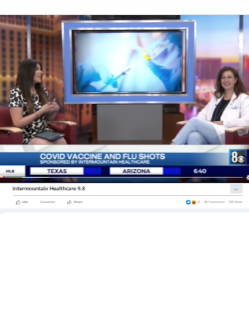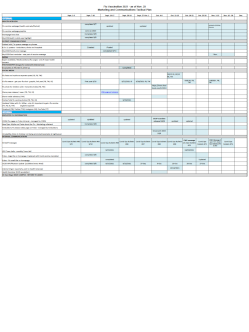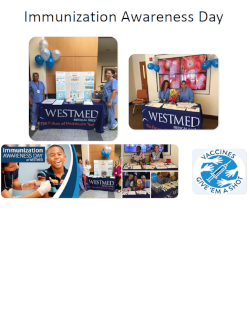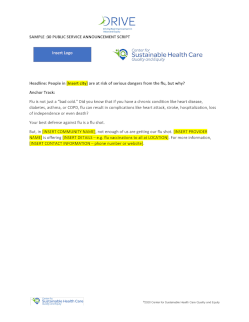Patient Education: Level 3
Implement advanced marketing tactics
Leverage advanced marketing channels to reach existing and new audiences with tailored messages around vaccination and drive engagement. Consider organizational goals, existing communications, timing, and budget in your planning and execution.
Once your organization has developed in-office materials and had success conducting proactive patient outreach, consider expanding your patient education efforts through advanced marketing tactics. To develop and implement these tactics, follow the steps below.
Step 1:
Engage relevant stakeholders
In addition to planning committee members who support patient education efforts, engage additional individuals who may be required for marketing projects that are more advanced, have a larger reach, and/or are more visible (e.g., IT, communications/public relations, leadership). Discuss how to work with them throughout the process and ensure that your project aligns with and leverages organizational activities, fits with existing capabilities and infrastructure, and remains within budget.
Step 2:
Identify expanded objectives and audiences
Determine what expanded immunization objectives to pursue based on organizational goals or priorities and identify which (if any) additional audiences should be targeted moving forward. Consider equity and representation and prioritize populations that historically have not had access to routine adult immunizations in your community.
Step 3:
Evaluate available tools and channels
Perform a communications audit by making a list of the channels your organization is using, which audiences you’re reaching through those channels, and what messages you’re sending to those audiences. Then, determine which additional channels could be used in the future. You might consider:
- Incorporating emails or text messages into the communications mix if you’ve primarily used phone calls and portal messages in the past.
- Using group-level communication platforms such as social media or PSAs if you’ve previously relied on individual messaging.
- Adding an inbound component to your communication efforts, such as a flu hotline or email address.
- Leveraging the channels of a partner or community organization to engage hard-to-reach audiences.
- Allocating money to paid media efforts such as ads on social media, digital/online media, newspapers/magazines, or TV/radio.
- Putting on a one-day or multiday event designed to draw media attention and give patients an easy, appointment-free way to get caught up on routine immunizations.
Step 4:
Develop a marketing plan
Develop a written plan that outlines your expanded objectives, the target audiences you’ve identified, and the details for engaging those patients. Be creative! Consider the specific audiences you serve and what could capture their attention, motivate their engagement, and help you reach your goals. Your plan should include organizational/departmental goals, immunization-related objectives, target audiences, communication channels, and tactics to engage audiences and meet goals/objectives.
For each tactic in your plan, include the following:
- Description
- Audience(s) targeted (age range, vaccine(s) needed, patient group, etc.)
- Vaccine(s) involved
- Channel(s) used
- Timing (date/time)
- Frequency (one-time, weekly, quarterly, etc.)
- Messaging
- Desired outcomes
- Relevant measures of success
- Anticipated staffing (which employees, how many hours of their time)
- Anticipated budget
Involve the appropriate people to review, provide feedback on, and ultimately approve the marketing plan. Once you have an approved plan, share information about it with all relevant staff and ensure those involved in execution understand their roles and responsibilities. Also consider training that is necessary for staff who are expected to complete activities outside of their typical tasks.
Step 5:
Execute tactics and measure success
With an approved plan, you can now focus on executing your tactics. Whether it’s developing digital ads before deploying them, crafting text messages before they are distributed, or staffing and promoting a flu hotline before fielding the first call, there is a lot of work required before your messaging reaches your target audience—and hopefully drives action. Expect to refine your project along the way and leverage feedback from a few highly engaged patients in your target audience to ensure you’re on the right path.
Evaluating results on an ongoing basis will give your organization valuable feedback on what’s working and what’s not. Determine what measures you will monitor, who will be responsible for tracking the measures and pulling/developing reports, and who should review the reports and advise on needed modifications. Measures should be related to the tactics you’ve chosen and may include:
- Clicks and email open rates for digital outreach
- Responses/clicks for text-based outreach
- Engagement (likes/responses/messages) for social media communications
- Impressions for paid or earned media efforts
- Number of inbound calls or emails to an immunization hotline/nurseline
- Attendees at special campaign-related events
- Appointments scheduled
- Vaccines administered

Sponsored Local News Segment
Intermountain Healthcare
Provides an example of a sponsored local news segment aimed at educating the public about the importance of receiving an annual flu shot. In this example, an organization’s medical director is interviewed by a news reporter and the segment is broadcasted on television and social media.
View Tool
Flu Vaccination Marketing and Communications Tactical Plan
UC San Diego Health
Outlines an organization’s internal and external marketing and communications activities during an influenza season.
View Tool
Fall Flu Campaign Example
Westmed Medical Group, P.C.
Showcases an organization’s Immunization Awareness Day activities that coincided with a fall flu campaign.
View Tool
Sample :30 Public Service Announcement Radio Script
Center for Sustainable Health Care Quality and Equity
Offers a short script for a radio Public Service Announcement (PSA) aimed at educating the public about the dangers of flu and importance of receiving the flu shot. This script is designed to be used in at-risk communities where flu vaccinations rates are low.
View ToolCampaign Planks
Provider & Staff Education
Clinical Support
IT / Documentation
Patient Education
